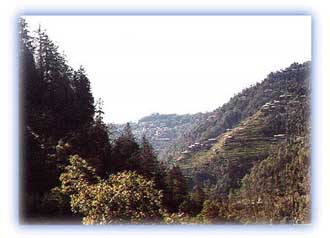Introduction to the Himalayas
· General Info
· Where to start

![]()
Shivaliks (Siwaliks, the Outer Himalayas or the Sub-Himalayas)
Forming the southernmost belt of the Himalayan range, the Shivaliks are also the lowest and narrowest range in the entire Himalayan system, having an average elevation of about 900 - 1200 m (3,000 to 4,000 feet) and in places, a width of only 16 km (10 miles). The Shivaliks rise steeply from the great northern plains of India and Pakistan and run parallel to the main ranges of the Himalayas towards the north,
from which they are separated by high mountains and deep valleys.
The name Shivalik is a Sanskrit word literally meaning
"Belonging to the Lord Shiva (of the Hindus)".
 |
| Green wooded hills in the lower mountain ranges in the Himalayas. Credit: Debangsu Sengupta |
Himachal (the Lesser Himalayas or the Lower Himalayas)
Lying between the Himadri region in the north and the Shivaliks to the south, the Himachal region forms the middle section of the Himalayan mountain chain. Lower than the Himadri or the Great Himalayas, this region has an average altitude of 3700 - 4500m above sea level (12,000 to 15,000 ft). It extends southeast from Pakistan and extrends through large parts of the Indian states of Jammu and Kashmir, Himachal Pradesh, Western Uttar Pradesh, Nepal and and the North-Eastern Himalayas. This region passes and glaciers and includes many of the 110 mountains in the Himalayas rising to heights up to 7300m (24,000 ft) or more above sea level.
 |
| Mount Everest, as seen from Kalapattar Credit: Stan Armington |
Himadri (the Great Himalayas, Higher Himalayas or the Great Himalayan Range)
The northernmost, longest and the most continous belt in the Himalayan system, the Himadri belt forms the backbone of the Himalayas. Lying well above the snow line with an average elevation of about 6100 m (20,000 ft), the Himadri dominates the extreme northern frontiers of India and the entire northern boundary of Nepal. It rises to its maximum height in Nepal containing nine of the fourteen
highest peaks in the world, all above 8000m above sea level.
All rights reserved